We thought it was finally time to catch up and write about what Southern Africans obsess about. As always, these are based on our short time in the countries, and may have little or no relationship to what you think.
Madagascar- A dead currency. The country got rid of the Malagasy franc in 2007 and replaced it with the ariary, which is worth 5 times more. However, nearly everyone still quotes prices in the old currency, as though you can still pay in it. It would be as though you went to Italy and everyone was still quoting prices in Italian lira, but you never really know. So, someone says 1,000 when asked a price. Is that 1,000 of the old currency or the new?
South Africa- Named Routes. Every road seems part of some touristic route. If we lived in South Africa, our driveway would probably be dubbed the "Andyandtara.com Driveway Route" by the government. It would come complete with nice signs. At one point we were driving down a tiny dirt road that no one uses and it had a huge sign saying something like "The Bob Robertson Mountain Route" and we just laughed.
Zimbabwe- Bartering. Because the Zim dollar is catastrophically worthless and people haven't fully adjusted to using dollars and rand, many people are still happy to trade. How much is that souvenir? "$10, but I'd rather trade it for your shoes." I was very tempted to trade the sunglasses that I bought for $1, but I really didn't need any of the junk they were selling...
Botswana- Urinal cakes. Tara has to take my word for this one. Every urinal has no fewer than 50 small urinal cakes, most often in a rainbow of colors and sometimes in a variety of shapes (cubes, round, thick, thin, etc.). All the bathrooms smell very nice.
Namibia- Germans. Sure, it was a German colony, but so were lots of places. Only Namibia has kept alive everything from German sausages to sauerkraut. Any German would feel right at home speaking German and many of the towns look like small German villages.
Lesotho- Walking in the road. The people of Lesotho don't really seem to understand cars. Because they see so few, they have the belief that the roads were built exclusively for them and their livestock to walk on. This proves problematic if you are going down the main road at 60 miles per hour at night, come around a turn, and discover a huge group of people right in front of you.
Swaziland- The King. Though most famous in most of the world for choosing a bride from a parade of topless, dancing teenagers each year (Google Reed Dance if you want to learn more), the king of Swaziland seems revered by all within the country. Let us know if you figure out what he does other than waste the country's money.
Mozambique- Male and female symbols. This sounds weird, but many places in Mozambique use the biological male and female symbols. You know, the little circles with an arrow coming off, like you might use in a biology class or the 1970s. We always had to do a double-take and figure out which was the right one to use.
Malawi- Teaching the language. In most places, people act as though we should know the local language, even when it is only spoken by about 100 people. In Malawi, they don't expect you to know it, but they always wanted to teach us. At least 20 people tried teaching us greetings for different times of day, but all failed.
Zambia- Coming to America. We had kids as young as 10 and adults well over 50 asking us how to get to America. At least we could tell the kids that they should study hard and maybe get a scholarship to an American school. The best we could come up with for the adults is that they should thinking about trying to get to an easier country like South Africa (even though South Africans mostly hate other Africans coming to their country).
And that ends another fine addition of obsessions. Hope that you enjoyed it!
Countries Visited
Tuesday, September 28, 2010
Friday, September 24, 2010
Tanzania: Oh, Golly, Ugali!
Tanzania has a good mix of food with a strong Indian influence. A strong Indian influence is something that we think every country should have, but you might find Tanzanian food difficult if you disagree. Like most things in Tanzania, food if very cheap as soon as you get out of the touristy areas. Enough babble--here are the pics.
One of our first stops was an Indian restaurant in Dar. The vegetarian thali (essentially a meal of different dishes for those who don't eat a lot of Indian) was very good and filling. And at $2, attractively priced. We aren't sure about the things that look and taste like giant Chex are, but we have never seen them at another Indian restaurant. Or anyplace on Earth for that matter.
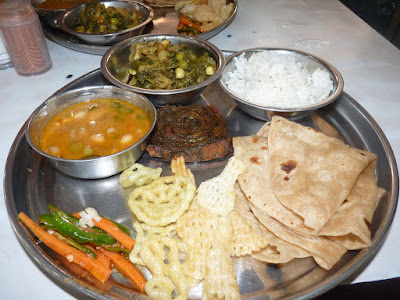 Tara had a really hard time finding yogurt in Tanzania, but she thought this one was okay.
Tara had a really hard time finding yogurt in Tanzania, but she thought this one was okay.
 We did find some hibiscus juice (of Ugandan origin, but found in Tanzania). It reminded us of all the tasty bissap of West Africa, but it wasn't as good. Probably it was missing the added dirt from the woman making it on the street.
We did find some hibiscus juice (of Ugandan origin, but found in Tanzania). It reminded us of all the tasty bissap of West Africa, but it wasn't as good. Probably it was missing the added dirt from the woman making it on the street.
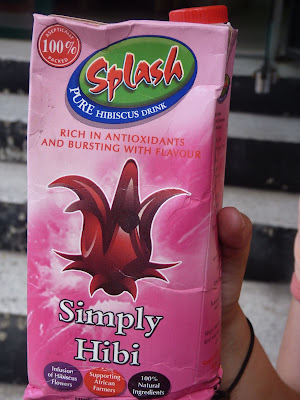 Tara ordered an octopus dish when we went to dinner with our friend Krisitin in Dar. IF you look at the picture closely, you can see the tentacles. At one point, her food tried to attack her, but she fought it off by slicing the tentacles into bits. Thanks for dinner, Kristin!
Tara ordered an octopus dish when we went to dinner with our friend Krisitin in Dar. IF you look at the picture closely, you can see the tentacles. At one point, her food tried to attack her, but she fought it off by slicing the tentacles into bits. Thanks for dinner, Kristin!
 We bought these balls on the street in Zanzibar mostly due to the glowing yellow color. As it turned out, they were terrific. Little balls of potato and Indian spices dipped in some kind of great batter (with a faint lemon taste) and fried. We ate many more.
We bought these balls on the street in Zanzibar mostly due to the glowing yellow color. As it turned out, they were terrific. Little balls of potato and Indian spices dipped in some kind of great batter (with a faint lemon taste) and fried. We ate many more.
 Zanzibar has a huge, touristy night market each night that is mostly seafood. Tara got this masala lobster and some "naan", which isn't so much naan as a generic flat bread, but not bad.
Zanzibar has a huge, touristy night market each night that is mostly seafood. Tara got this masala lobster and some "naan", which isn't so much naan as a generic flat bread, but not bad.
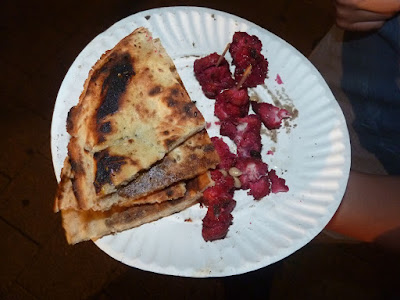 On my generic garlicly semi-flat bread, I also go some salad and hot sauce, which improved its taste. It is funny to see all the Indian-inspired breads that aren't quite actually Indian.
On my generic garlicly semi-flat bread, I also go some salad and hot sauce, which improved its taste. It is funny to see all the Indian-inspired breads that aren't quite actually Indian.
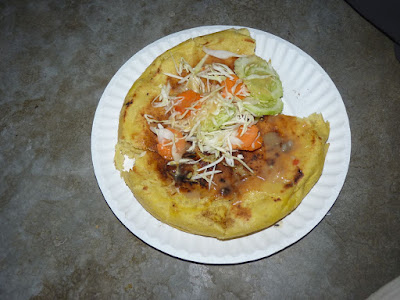 Zanzibar has people selling fresh squeezed sugar juice everywhere, and we decided to try some despite not liking it much in South America. As it turns out, it was amazing. They add ginger and lime to make it extra tasty.
Zanzibar has people selling fresh squeezed sugar juice everywhere, and we decided to try some despite not liking it much in South America. As it turns out, it was amazing. They add ginger and lime to make it extra tasty.
 I watched a couple of Indians buy a soup-like bowl of stuff from a vendor and since they might have been the only locals around, I followed their lead. I got this super cheap concoction of broth, beans, potato, and other unidentifiable stuff for maybe 30 cents. Not bad, but not award winning.
I watched a couple of Indians buy a soup-like bowl of stuff from a vendor and since they might have been the only locals around, I followed their lead. I got this super cheap concoction of broth, beans, potato, and other unidentifiable stuff for maybe 30 cents. Not bad, but not award winning.
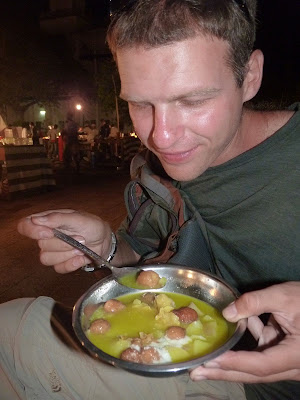 This touristy night market has many people selling "Zanzibar pizza", which is a thin, crepe-like dough with fillings inside. We got banana mango, which wasn't bad, but not the best thing ever.
This touristy night market has many people selling "Zanzibar pizza", which is a thin, crepe-like dough with fillings inside. We got banana mango, which wasn't bad, but not the best thing ever.
 Here is a guy squeezing the sugar juice. All made fresh right in front of your eyes. They run it through the machine many times, folding it in half every couple of runs to get more. A whole cane makes about one big glass of juice.
Here is a guy squeezing the sugar juice. All made fresh right in front of your eyes. They run it through the machine many times, folding it in half every couple of runs to get more. A whole cane makes about one big glass of juice.
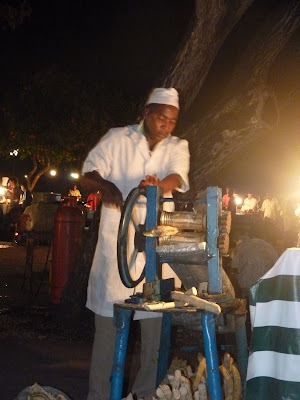 Everyone had what they called falafel. We bought one, but it wasn't like any falafel we had ever had. Fluffy and filled with bad tastes, we fought over who had to eat it. I finally ate most of it with a huge side of hot sauce.
Everyone had what they called falafel. We bought one, but it wasn't like any falafel we had ever had. Fluffy and filled with bad tastes, we fought over who had to eat it. I finally ate most of it with a huge side of hot sauce.
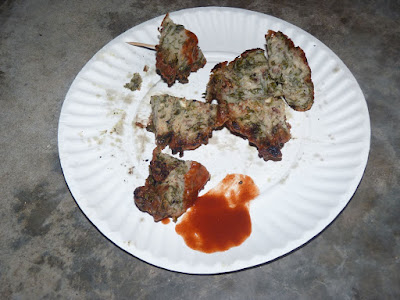 I wonder what this is. While on a bus, I used the rest of the little money we had at the time to buy a package of random fried things. One was a samosa, one was a banana, and then there was this. It had some vaguely meaty stuff inside and was then breaded and fried. Not so great.
I wonder what this is. While on a bus, I used the rest of the little money we had at the time to buy a package of random fried things. One was a samosa, one was a banana, and then there was this. It had some vaguely meaty stuff inside and was then breaded and fried. Not so great.
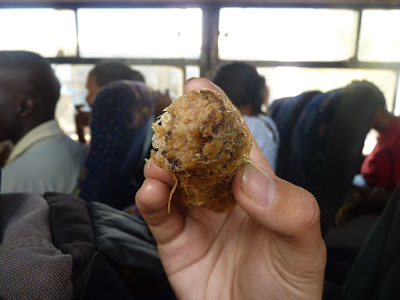 Like most West African and East African countries, Tanzania has its own maize or cassava fluffy stuff that you eat with your hands and dip into some kind of stew. In Tanzania, maize is more common, and it is called ugali. Fortunately, they don't like it fermented like some countries, so it has little taste and takes on the taste of the sauce. I like it. Tara tolerates it. Most Westerners despise it. The ugali to stew ratio in this picture seems typical, though most places are nice enough to give some extra sauce if you ask.
Like most West African and East African countries, Tanzania has its own maize or cassava fluffy stuff that you eat with your hands and dip into some kind of stew. In Tanzania, maize is more common, and it is called ugali. Fortunately, they don't like it fermented like some countries, so it has little taste and takes on the taste of the sauce. I like it. Tara tolerates it. Most Westerners despise it. The ugali to stew ratio in this picture seems typical, though most places are nice enough to give some extra sauce if you ask.
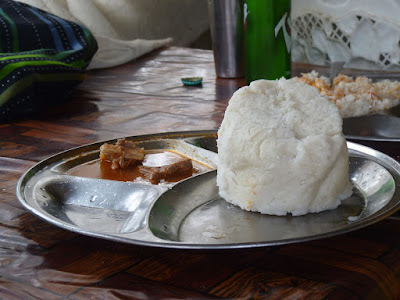 When visiting our friend, Andrew, in his village outside of Mwanza, we were buying fruit and I saw these things. We asked the lady what they were (actually, Andrew did in his impressive Swahili for the short time he has lived there), and she replied that they are called the same word as an ant. We asked how to eat it, and she took a bite of one and looked like she was about to barf. So, I immediately bought some. They smell very nice like a flower. They taste a weird mixture of floral and bitter and sour. They are not good. I have no idea who eats them. None of us could stomach more than about a third of one and they are only the size of an olive.
When visiting our friend, Andrew, in his village outside of Mwanza, we were buying fruit and I saw these things. We asked the lady what they were (actually, Andrew did in his impressive Swahili for the short time he has lived there), and she replied that they are called the same word as an ant. We asked how to eat it, and she took a bite of one and looked like she was about to barf. So, I immediately bought some. They smell very nice like a flower. They taste a weird mixture of floral and bitter and sour. They are not good. I have no idea who eats them. None of us could stomach more than about a third of one and they are only the size of an olive.
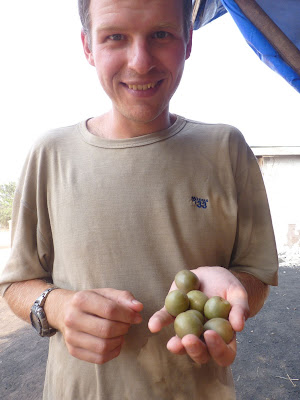 During our time in the Serengetti, Tara and I each cooked a meal. Here is Tara tasting the pasta dish that we had for dinner that night. We were able to pay a dollar or two to the kitchen staff to use the facilities, which was about 20 times cheaper than it would have been to pay people for dinner.
During our time in the Serengetti, Tara and I each cooked a meal. Here is Tara tasting the pasta dish that we had for dinner that night. We were able to pay a dollar or two to the kitchen staff to use the facilities, which was about 20 times cheaper than it would have been to pay people for dinner.
 Pulau is a popular rice dish in Tanzania, which is sort of a rice pilaf with some Indian seasoning (or other seasoning) in it. Normally, it is way better than normal rice. Here is a typical dish that comes with the pulau, the meat stew, and some greens.
Pulau is a popular rice dish in Tanzania, which is sort of a rice pilaf with some Indian seasoning (or other seasoning) in it. Normally, it is way better than normal rice. Here is a typical dish that comes with the pulau, the meat stew, and some greens.
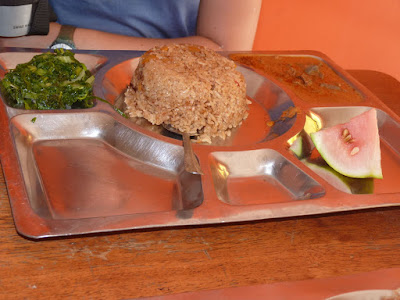 Azam is a company that makes many Tanzania products, including the ubiquitous juice box that I am consumming in this picure. They aren't real juice, but they have a bit of juice in them.
Azam is a company that makes many Tanzania products, including the ubiquitous juice box that I am consumming in this picure. They aren't real juice, but they have a bit of juice in them.
 Our friend, Andrew, decided to experiment with battered, deep-fried bananas. His first round was not so good, with all the batter falling off, but the latter rounds were terrific. I ate about five bananas. Here he is with his best crazy face like Dr. Frankenstein with his monster.
Our friend, Andrew, decided to experiment with battered, deep-fried bananas. His first round was not so good, with all the batter falling off, but the latter rounds were terrific. I ate about five bananas. Here he is with his best crazy face like Dr. Frankenstein with his monster.
 That concludes our show. Hope that you enjoyed it. I give Tanzania high marks for food, with Zanzibar being an especially good cuisine location. Tara liked the Indian and Zanzibari stuff, but thought that other Tanzanian food was boring. Hooray for the Indians making the food tastier!
That concludes our show. Hope that you enjoyed it. I give Tanzania high marks for food, with Zanzibar being an especially good cuisine location. Tara liked the Indian and Zanzibari stuff, but thought that other Tanzanian food was boring. Hooray for the Indians making the food tastier!
One of our first stops was an Indian restaurant in Dar. The vegetarian thali (essentially a meal of different dishes for those who don't eat a lot of Indian) was very good and filling. And at $2, attractively priced. We aren't sure about the things that look and taste like giant Chex are, but we have never seen them at another Indian restaurant. Or anyplace on Earth for that matter.
Wednesday, September 22, 2010
Tanzania: Serengetti Safari
This picture probably won't mean much to anyone who's not in my writers' group. But if you are, or if you happen to know the name of the heroine of the novel I've been working on for the last few years, then you will appreciate the fact that I found this sign in Moshi, Tanzania, the very town where I finally finished my first draft of it!
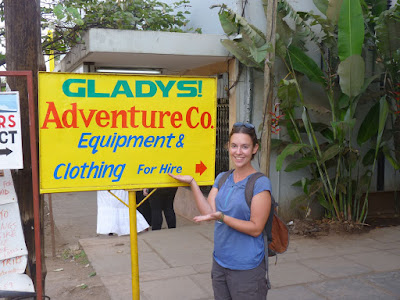
OK, so, as Andy alluded to in his last post, Tanzania is the first country (out of 48 now!) on our trip where he and I spent more than a couple of hours apart. While he spent six days climbing Mount Kilimanjaro with our friend Andrew, I hung out at the wonderful Kilimanjaro Coffee Lounge on Chagga Street in Moshi, drinking a lot of masala tea and writing. Perhaps this will become a pilgrimmage site when my magnum opus is published and I become as rich and famous as J.K. Rowling. (Meanwhile, I'm still working on typing the manuscript up, so you can't read it yet.)
Our next destination after Moshi was Mwanza, Tanzania's second-largest city. After another long, painful bus ride, we made it to Buswelu, the village on Mwanza's outskirts where we stayed with Andrew and his fellow volunteer Josh, who are building an orphanage in the area. The foundations have now been laid, and we were able to visit the construction site and admire them. This building will ultimately house 50 orphans.
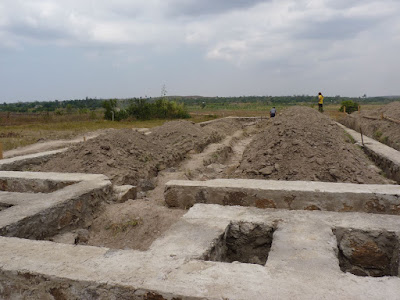 If you would like to help make this building grow, you can learn more about the project and how to make a donation at the site www.upendo.org.uk. I don't think there is a direct link up yet for donations, but you can e-mail the woman in charge, and once an online system is up, I'll post again!
If you would like to help make this building grow, you can learn more about the project and how to make a donation at the site www.upendo.org.uk. I don't think there is a direct link up yet for donations, but you can e-mail the woman in charge, and once an online system is up, I'll post again!
The area around Mwanza has all of these nifty rock formations. They are even found in Lake Victoria (Mwanza is Tanzania's major port on the lake, Africa's largest).

From Mwanza, we then turned around and headed back east in a 4x4 for a three-day safari in Serengetti National Park (yes, that's the one you've seen in all those nature documentaries) and the Ngorongoro Crater.
Unlike the open safari vehicles we've ridden in in parks in southern Africa, the vehicles for Serengetti are closed jeeps, but with raised roofs so you can stand up and stick your head out for better wildlife viewing.
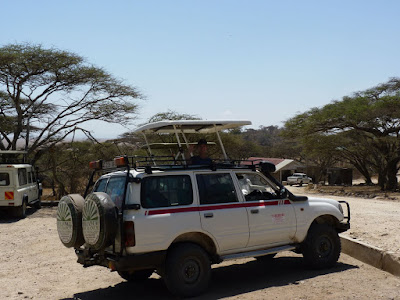
Safaris in Tanzania are quite expensive--mostly because park fees in Tanzania are very high ($50 per person, per day) and because traversing the parks requires a lot of driving, and therefore fuel. We debated not going at all, but in the end we were glad we sprang for it, because we did see some new animals and birds and some very large groups of animals, which was cool. To the pictures!
Burchell's or common zebras--quite numerous in the Serengetti and not afraid of cars at all, so you could get very close.
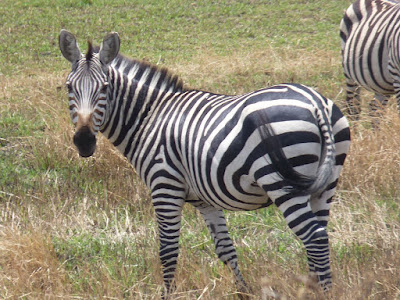 New antelope #1: the topi! Andy likes this animal because he says its like a butchering diagram--its different cuts of meat are different colors.
New antelope #1: the topi! Andy likes this animal because he says its like a butchering diagram--its different cuts of meat are different colors.
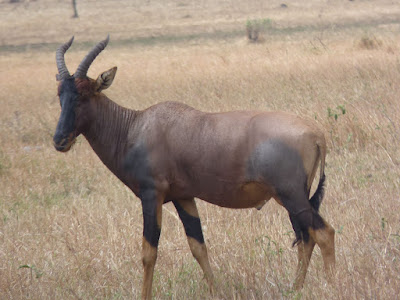 We were able to get out of the car and walk across a bridge at one point into the bush, where we saw a few black and white colobus monkeys! They are very shaggy and look a little bit like skunks with the coloring.
We were able to get out of the car and walk across a bridge at one point into the bush, where we saw a few black and white colobus monkeys! They are very shaggy and look a little bit like skunks with the coloring.
 A gazillion hippos in one of Serengetti's many watering holes.
A gazillion hippos in one of Serengetti's many watering holes.
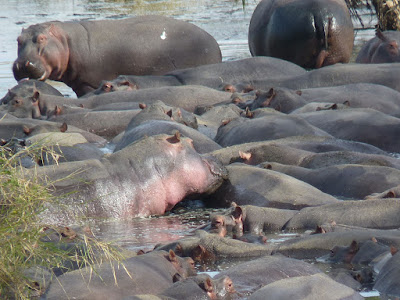 New antelope #2: the hartebeest! So called because its antlers sort of make a heart shape. It also has a very long face.
New antelope #2: the hartebeest! So called because its antlers sort of make a heart shape. It also has a very long face.
 Nice eagle in a tree.
Nice eagle in a tree.
 Hyena! We were very excited to finally see some. We saw three or four spotted hyenas on the trip, but none as close up as this one, which was just lounging beside the road in the morning when our jeep passed by.
Hyena! We were very excited to finally see some. We saw three or four spotted hyenas on the trip, but none as close up as this one, which was just lounging beside the road in the morning when our jeep passed by.
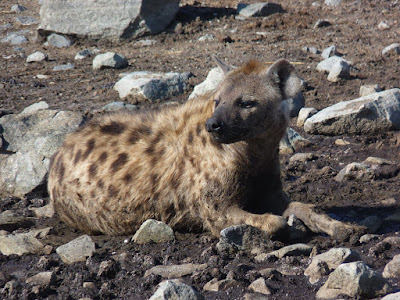 We saw a new subspecies of giraffe in the Serengetti: the Maasai giraffe. It's a bit darker than others we'd seen further south.
We saw a new subspecies of giraffe in the Serengetti: the Maasai giraffe. It's a bit darker than others we'd seen further south.
 New antelope #3: Grant's gazelle. We also saw Thomson's gazelles, which are smaller.
New antelope #3: Grant's gazelle. We also saw Thomson's gazelles, which are smaller.
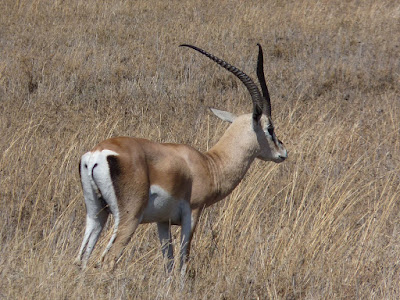 Here is one of our many lion sightings. This juvenile male and his brother were hanging out around some big rocks.
Here is one of our many lion sightings. This juvenile male and his brother were hanging out around some big rocks.
 This may be Andy's best lizard picture ever. These cool red and blue agama lizards were common around park headquarters.
This may be Andy's best lizard picture ever. These cool red and blue agama lizards were common around park headquarters.
 The superb starling. I like how its eye matches its breast.
The superb starling. I like how its eye matches its breast.
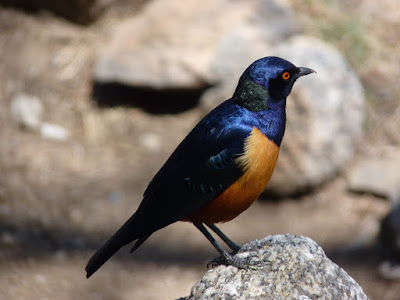 We saw two types of jackals prowling around the open savannah. I think that this one is the more common golden jackal.
We saw two types of jackals prowling around the open savannah. I think that this one is the more common golden jackal.
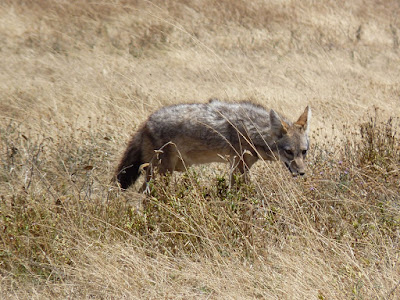 These elephants were not far from the bathrooms at our picnic stop in Ngorogoro Crater. Check out the crazy long tusk on the left one!
These elephants were not far from the bathrooms at our picnic stop in Ngorogoro Crater. Check out the crazy long tusk on the left one!
 Ngorogoro Crater is a huge sunken area with a regular water source, so large groups of animals flock to it. It can get a bit crowded with safari vehicles--especially if there are lions or rhinos to look at--but it was also really beautiful and definitely worth visiting.
Ngorogoro Crater is a huge sunken area with a regular water source, so large groups of animals flock to it. It can get a bit crowded with safari vehicles--especially if there are lions or rhinos to look at--but it was also really beautiful and definitely worth visiting.
We saw large groups of wildebeest--white-bearded ones, which are different from the blue ones we saw in southern Africa.
 Another bird for my aviary: the little bee-eater. We also saw this bird in Zambia. So pretty!
Another bird for my aviary: the little bee-eater. We also saw this bird in Zambia. So pretty!
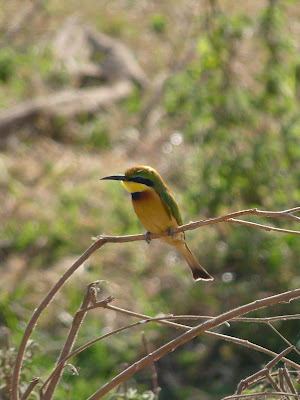 Oh, and these crowned cranes are definitely going in the aviary. The national bird of Uganda, which we may have mentioned before. Pairs of them are all over the crater.
Oh, and these crowned cranes are definitely going in the aviary. The national bird of Uganda, which we may have mentioned before. Pairs of them are all over the crater.
 The crater has a soda lake, whose minerals attract thousands of flamingos.
The crater has a soda lake, whose minerals attract thousands of flamingos.
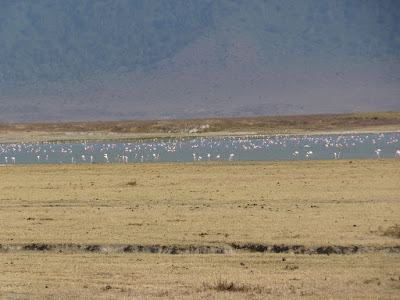 In the crater, Andy and I finally completed our "big five" with this sighting of two black rhinos. Sorry for the poor picture, they were kind of far away.
In the crater, Andy and I finally completed our "big five" with this sighting of two black rhinos. Sorry for the poor picture, they were kind of far away.
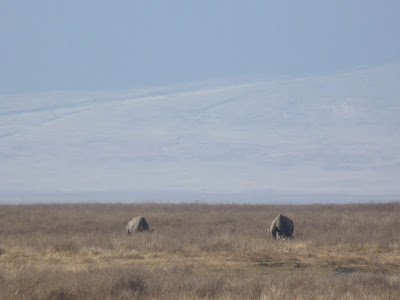 Another hyena, this one in the crater. We only saw solitary ones, none marching in formation like they do in The Lion King.
Another hyena, this one in the crater. We only saw solitary ones, none marching in formation like they do in The Lion King.
 Here's a view out over the savannahlands from park headquarters on the last day of our trip, when we turned around and drove back through the Serengetti to Mwanza. They just go on and on.
Here's a view out over the savannahlands from park headquarters on the last day of our trip, when we turned around and drove back through the Serengetti to Mwanza. They just go on and on.
 Another jackal--I think that this one is the rarer black-backed one. Forgive me if I've messed up the jackals, I know we do have pictures of both kinds I've mentioned...
Another jackal--I think that this one is the rarer black-backed one. Forgive me if I've messed up the jackals, I know we do have pictures of both kinds I've mentioned...
 On our way back through the park, there was a tree that had at least 20 female lions underneath it. The camera just couldn't fit them all in at once--here's a small cross-section of them. So lazy-looking. Funnily enough, the male was alone, across the road, under his own tree. Guess he needed some me-time.
On our way back through the park, there was a tree that had at least 20 female lions underneath it. The camera just couldn't fit them all in at once--here's a small cross-section of them. So lazy-looking. Funnily enough, the male was alone, across the road, under his own tree. Guess he needed some me-time.
 We arrived back in Buswelu safe and sound for a final night out with Andrew and Josh. Then, the next morning, we were off at 4AM, heading toward the Rwanda border in a clown bus (my own term for a bus that you think can't possibly fit another single person on it, but then it fits 20 more).
We arrived back in Buswelu safe and sound for a final night out with Andrew and Josh. Then, the next morning, we were off at 4AM, heading toward the Rwanda border in a clown bus (my own term for a bus that you think can't possibly fit another single person on it, but then it fits 20 more).
On our way out of the country, I took this picture--for some reason, there are giant Coke bottles like this decorating the landscape all over Western Tanzania.
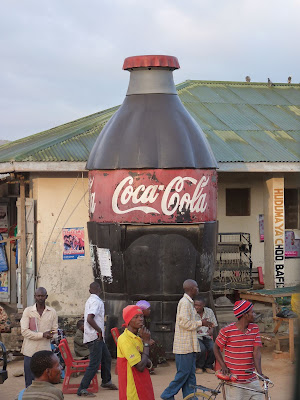 So, that was it for Tanzania. We spent 18 days, making it the longest continuous stretch we've had in one country since Madagascar. Like Madagascar, it was a serious combination of very expensive (safari, Kilimanjaro) and very cheap (hotels, food) experiences. Not my favorite country in Africa, but I did really enjoy Zanzibar, the safari, and village life (not to mention getting a six-day break from racing around and finally finishing my novel!).
So, that was it for Tanzania. We spent 18 days, making it the longest continuous stretch we've had in one country since Madagascar. Like Madagascar, it was a serious combination of very expensive (safari, Kilimanjaro) and very cheap (hotels, food) experiences. Not my favorite country in Africa, but I did really enjoy Zanzibar, the safari, and village life (not to mention getting a six-day break from racing around and finally finishing my novel!).
It was also great to spend time with our friends Kristen and Andrew, both of whom happen to be hardcore travelers and have given us loads of invaluable recommendations over the last year. Thanks, guys, and hope to meet you both again before our travels end.
OK, so, as Andy alluded to in his last post, Tanzania is the first country (out of 48 now!) on our trip where he and I spent more than a couple of hours apart. While he spent six days climbing Mount Kilimanjaro with our friend Andrew, I hung out at the wonderful Kilimanjaro Coffee Lounge on Chagga Street in Moshi, drinking a lot of masala tea and writing. Perhaps this will become a pilgrimmage site when my magnum opus is published and I become as rich and famous as J.K. Rowling. (Meanwhile, I'm still working on typing the manuscript up, so you can't read it yet.)
Our next destination after Moshi was Mwanza, Tanzania's second-largest city. After another long, painful bus ride, we made it to Buswelu, the village on Mwanza's outskirts where we stayed with Andrew and his fellow volunteer Josh, who are building an orphanage in the area. The foundations have now been laid, and we were able to visit the construction site and admire them. This building will ultimately house 50 orphans.
The area around Mwanza has all of these nifty rock formations. They are even found in Lake Victoria (Mwanza is Tanzania's major port on the lake, Africa's largest).
From Mwanza, we then turned around and headed back east in a 4x4 for a three-day safari in Serengetti National Park (yes, that's the one you've seen in all those nature documentaries) and the Ngorongoro Crater.
Unlike the open safari vehicles we've ridden in in parks in southern Africa, the vehicles for Serengetti are closed jeeps, but with raised roofs so you can stand up and stick your head out for better wildlife viewing.
Safaris in Tanzania are quite expensive--mostly because park fees in Tanzania are very high ($50 per person, per day) and because traversing the parks requires a lot of driving, and therefore fuel. We debated not going at all, but in the end we were glad we sprang for it, because we did see some new animals and birds and some very large groups of animals, which was cool. To the pictures!
Burchell's or common zebras--quite numerous in the Serengetti and not afraid of cars at all, so you could get very close.
We saw large groups of wildebeest--white-bearded ones, which are different from the blue ones we saw in southern Africa.
On our way out of the country, I took this picture--for some reason, there are giant Coke bottles like this decorating the landscape all over Western Tanzania.
It was also great to spend time with our friends Kristen and Andrew, both of whom happen to be hardcore travelers and have given us loads of invaluable recommendations over the last year. Thanks, guys, and hope to meet you both again before our travels end.
Monday, September 20, 2010
Tanzania: Climbing Kilimanjaro
Having watched more nature documentaries than I can count as a kid, I have always thought of climbing Kilimanjaro, the tallest mountain in Africa, as one of the great challenges of the continent. Tara, on the other hand, considers mountain climbing the worst form of torture. Luckily for me, it turned out that our travel friend, Andrew, whom we first met on the way to Venezuela last year, is volunteering in Tanzania and he was up for a nice mountain hike. So, I convinced him to climb Kilimanjaro while we left Tara at a nice hotel to finish her current writing project.
The first thing you need to know if you want to climb Kili is that it is expensive. Because a.) the country of Tanzania tries to squeeze every possible dime out of foreign tourists, and b.) it has apparently become very popular for Brits to climb Kilimanjaro "for charity" after some famous people did it, the cost to climb the mountain has skyrocketed in the last decade. You can now expect to pay about $1000 if you just show up in Moshi and book a trip or more if you book in advance. Over $600 of that goes straight to the national parks and you pay it separately by Visa credit or debit card.
This brings us to the pictures. Every person will have roughly one guide and three porters for them. What do the porters carry? Tents, tables, chairs, warm clothing, food, and any pet elephants you bring. Most people do not have any belongings carried by the porter, but all the stuff needed by the tour company for you must be carried. Here are porters carrying stuff up the mountain. Each porter is limited to 20 kilograms plus his own stuff (did not see any women porters), and many carry the load on their heads.
 The mountain has many distinct ecosystems, which the first day mainly going through rainforest. These flowers are common up until about 3000 meters of elevation, but this one had a cute bug inside.
The mountain has many distinct ecosystems, which the first day mainly going through rainforest. These flowers are common up until about 3000 meters of elevation, but this one had a cute bug inside.
 In our case, they sent a massive dining tent for just the two of us. Here is our friend, Andrew, in our huge eating tent about to have some tea and popcorn. I love popcorn, and was happy that it was so popular on the mountain. I do not care about tea, really, but Andrew does not have sugar in his, which meant that I could at least add tons of sugar to mine.
In our case, they sent a massive dining tent for just the two of us. Here is our friend, Andrew, in our huge eating tent about to have some tea and popcorn. I love popcorn, and was happy that it was so popular on the mountain. I do not care about tea, really, but Andrew does not have sugar in his, which meant that I could at least add tons of sugar to mine.
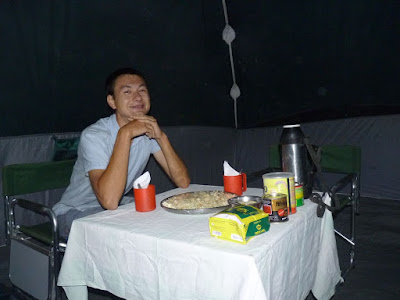 After the rainforest, it becomes what I might call scrubland, but which they call moorland. The trees become short with lots of lichen and small plants. This is that region.
After the rainforest, it becomes what I might call scrubland, but which they call moorland. The trees become short with lots of lichen and small plants. This is that region.
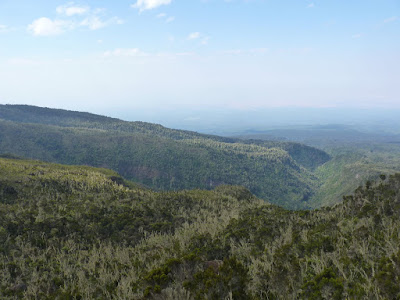 Further up, the trees stop altogether and it just becomes rocky with the occasional green. This is when it is not covered by fog, which happens a lot.
Further up, the trees stop altogether and it just becomes rocky with the occasional green. This is when it is not covered by fog, which happens a lot.
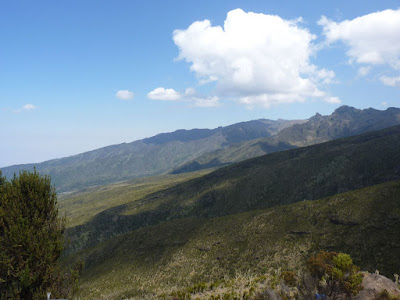 We were not prepared for the massive number of hikers. On our route, the 6 day route, 170 hikers (each with 3 porters and a guide) started on the same day. This meant that huge tent cities spring up at night. This photo was taken early in the day, but three hours later, this entire area was covered in hundreds of tents.
We were not prepared for the massive number of hikers. On our route, the 6 day route, 170 hikers (each with 3 porters and a guide) started on the same day. This meant that huge tent cities spring up at night. This photo was taken early in the day, but three hours later, this entire area was covered in hundreds of tents.
 Another view looking down the mountain. Really nice when not fogged over.
Another view looking down the mountain. Really nice when not fogged over.
 Our friend Andrew catches a quick nap when we stopped to rest. The hiking for the first three days is not all that difficult, but the uphill does become tiring at times.
Our friend Andrew catches a quick nap when we stopped to rest. The hiking for the first three days is not all that difficult, but the uphill does become tiring at times.
 As you get closer to the top, all that remains is rock and gravel. The last part of the hike is up a steep, gravel area much like this, though it is also in the middle of the night.
As you get closer to the top, all that remains is rock and gravel. The last part of the hike is up a steep, gravel area much like this, though it is also in the middle of the night.
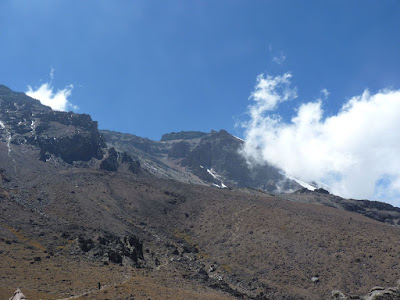 These are called Lava Towers and are at about 4600 meters. Kilimanjaro is an inactive volcano (our guide said that it last erupted about 20,000 years ago), and lava formations are common on the mountain.
These are called Lava Towers and are at about 4600 meters. Kilimanjaro is an inactive volcano (our guide said that it last erupted about 20,000 years ago), and lava formations are common on the mountain.
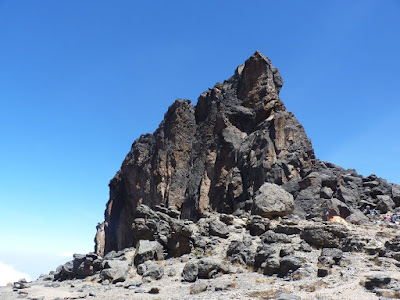 All the way up to at least 5000 meters, lots of mice survive. They are helped by food from climbers, I am sure, but impressive at how high they go.
All the way up to at least 5000 meters, lots of mice survive. They are helped by food from climbers, I am sure, but impressive at how high they go.
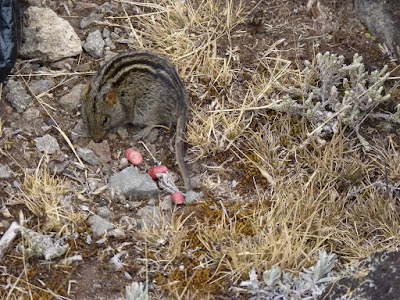 Between about 3000 and 4000 meters, these amazing tree like plants live. No idea what they are, but I really like them. These also had a nice waterfall in the background.
Between about 3000 and 4000 meters, these amazing tree like plants live. No idea what they are, but I really like them. These also had a nice waterfall in the background.
 This is not the very top of the mountain, but is close. Towards the top, several glaciers exist all year round.
This is not the very top of the mountain, but is close. Towards the top, several glaciers exist all year round.
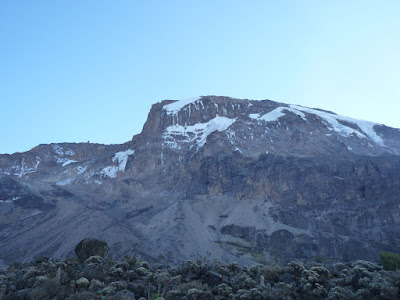 In this picture, I tried to set my camera timer to 2 seconds because it was a busy path and I thought I could make it. I almost made it into position. This was on day four, and Andrew and I were feeling really good. We were the fastest hikers around that day.
In this picture, I tried to set my camera timer to 2 seconds because it was a busy path and I thought I could make it. I almost made it into position. This was on day four, and Andrew and I were feeling really good. We were the fastest hikers around that day.
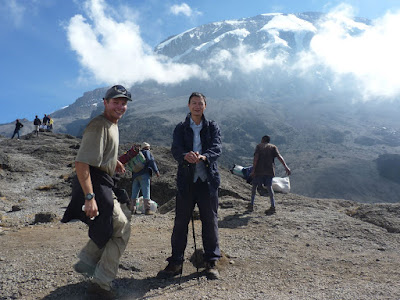 After getting to camp around 1pm on Day 4, we then got up at midnight to start hiking to the top. Many hikers leave at 11pm, but our guide thought that we should be fine if we left by 12:30 because we were fast hikers. Unfortunately, after a few hours, Andrew began to experience altitude problems in the form of terrible stomach pains. We agreed to split up so that I could make the top before sunrise. I then made my guide hike for the next three hours with one 3 minute break to pee. We reached the summit at 6:15am, just in time for the 6:21 sunrise. It was just me and 4 other tourists at the top at that point. I was tired, but otherwise in good shape.
After getting to camp around 1pm on Day 4, we then got up at midnight to start hiking to the top. Many hikers leave at 11pm, but our guide thought that we should be fine if we left by 12:30 because we were fast hikers. Unfortunately, after a few hours, Andrew began to experience altitude problems in the form of terrible stomach pains. We agreed to split up so that I could make the top before sunrise. I then made my guide hike for the next three hours with one 3 minute break to pee. We reached the summit at 6:15am, just in time for the 6:21 sunrise. It was just me and 4 other tourists at the top at that point. I was tired, but otherwise in good shape.
 Here is a picture from sunrise at Uhuru Peak, the top of Kilimanjaro.
Here is a picture from sunrise at Uhuru Peak, the top of Kilimanjaro.
 Just off the peak is also a very nice glacier.
Just off the peak is also a very nice glacier.
 And a closer shot of the glacier.
And a closer shot of the glacier.
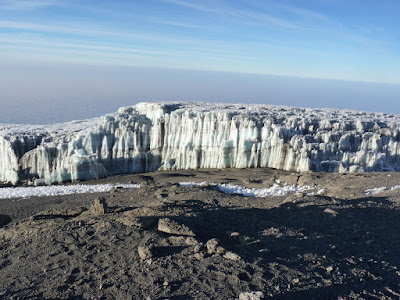 After resting at the top, we started on our way back down. About 20 minutes down, we met Andrew and our other guide on the way up. So, despite the weird looks from the guides, I climbed back to the top for a second time. I am the one who Tara says looks like a girl in this picture.
After resting at the top, we started on our way back down. About 20 minutes down, we met Andrew and our other guide on the way up. So, despite the weird looks from the guides, I climbed back to the top for a second time. I am the one who Tara says looks like a girl in this picture.
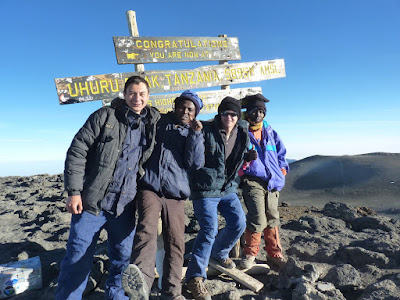 We know a few people who have climbed Kilimanjaro and have met a few others on this trip. Most all have said it might be the hardest thing they have ever done. That is not the case for me, but I am still shocked by just how many people are able to make it up this very difficult mountain. No special tools or skills required, but you need a whole lot of drive and a bit of luck to make it all the way to the top. It was good to do, but I probably would not rush to do it again.
We know a few people who have climbed Kilimanjaro and have met a few others on this trip. Most all have said it might be the hardest thing they have ever done. That is not the case for me, but I am still shocked by just how many people are able to make it up this very difficult mountain. No special tools or skills required, but you need a whole lot of drive and a bit of luck to make it all the way to the top. It was good to do, but I probably would not rush to do it again.
The first thing you need to know if you want to climb Kili is that it is expensive. Because a.) the country of Tanzania tries to squeeze every possible dime out of foreign tourists, and b.) it has apparently become very popular for Brits to climb Kilimanjaro "for charity" after some famous people did it, the cost to climb the mountain has skyrocketed in the last decade. You can now expect to pay about $1000 if you just show up in Moshi and book a trip or more if you book in advance. Over $600 of that goes straight to the national parks and you pay it separately by Visa credit or debit card.
This brings us to the pictures. Every person will have roughly one guide and three porters for them. What do the porters carry? Tents, tables, chairs, warm clothing, food, and any pet elephants you bring. Most people do not have any belongings carried by the porter, but all the stuff needed by the tour company for you must be carried. Here are porters carrying stuff up the mountain. Each porter is limited to 20 kilograms plus his own stuff (did not see any women porters), and many carry the load on their heads.
Subscribe to:
Posts (Atom)
